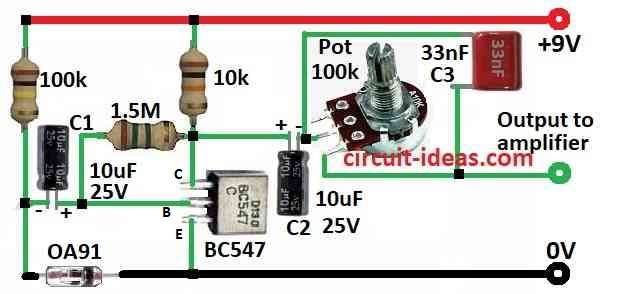This small and Simple Rain Sound Effect Generator Circuit it like a rain sound maker in box.
It uses electric parts to make sound and almost same like real rain drop.
This soft sound are good for many things like background music or sleep timer or help us in dreaming.
So next time if we want to hear rain and feel calm then we can use this circuit and make our own small rainy day.
Circuit Working:

Parts List:
| Component Type | Component Details | Quantity |
|---|---|---|
| Resistors (All resistors are 1/4 watt) | 100k | 1 |
| 10k | 1 | |
| 1.5M | 1 | |
| Potentiometer 100k | 1 | |
| Capacitors | PPC 33nF | 1 |
| Electrolytic 10µF 25V | 2 | |
| Semiconductors | Transistor BC547 | 1 |
| Diode OA91 | 1 |
This circuit make rain sound like real rain noise it is good for music or radio show use.
It uses one germanium diode to make noise and this diode get power straight rather then small amplifier that makes sound louder.
There is high pass filter which is made with P1 and C3.
We can change it to make sound like small rain or big heavy rain.
It we do not use much power so 9V battery is OK to use.
Also we can use any NPN transistor not just BC547.
Formulas:
We can make rain sound circuit by building small oscillator which makes noise signal like rain sound.
Above is circuit diagram it shows how to connect parts and also give formula to find part values.
Capacitor Value:
The capacitor 10µF is to help filter the noise signal.
Big capacitor filters more and give soft sound whereas small capacitor keep high sound which is more sharp.
Cut-off frequency for high-pass filter is:
fc = 1 / 2πRC
where:
- fc is the cut-off frequency
- R is the resistor value for 100k
- C is the capacitor value for 10µF
We can change potentiometer and capacitor to make different sound and change tone and volume of noise so it can sound like soft rain or heavy rain.
How to Build:
To build a Simple Rain Sound Effect Generator Circuit need to follow the below mentioned steps:
Assemble the Circuit:
- Connect OA91 diode anode to base of BC547 transistor using capacitor C1.
- Diodes cathode is connected to ground.
- Emitter of transistor also is connected to ground.
- Collector of transistor connect to 10k resistor and then to positive side.
- Connect 10µF capacitor C2 from collector.
- Connect 10µF capacitor C1 from base.
- Connect 33nF capacitor C3 to one side of 100k potentiometer and other side connects to amplifier output.
Adjust the Circuit:
- Turn potentiometer P1 to change low end sound filter and this changes the rain sound effect.
Test the Circuit:
- Play sound through amplifier.
- Turn potentiometer slowly to get nice rain sound we like.
Optional Changes:
- Try different part values to change how rain sound feel.
- We can also try other NPN transistors instead of BC547 so maybe sound will change.
Important Note:
- Check all wires and parts and be sure they connect right and face correct way or it can break the circuit.
Conclusion:
Simple Rain Sound Effect Generator Circuit is easy and useful circuit which makes sound like real rain.
We can use it for many things like music, radio show or just to feel calm with rain sound.
Leave a Reply